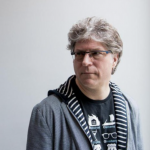
Dani Spinosa asks Bertrand Gervais about the place of digital literatures across Francophone and Anglophone Canada, the issue of genre and labelling in the field, and his work with NT2. Gervais here foregrounds the ground-breaking contributions of Québécois writers, artists, and scholars that are foundational to Canadian digital humanities and media studies across the country, and speaks to how important it is that digital publishing prioritize accessibility and evolution.
Dani Spinosa (DS): How did you get into electronic literature? How were you introduced to the field?
Bertrand Gervais (BG): I was introduced to the field in the early 1990. As a professor, I’m a specialist of semiotics and of contemporary American literature. One of my main areas of research was and still is the complexification of narratives. My work dealt with the maze or the labyrinth as a guiding metaphor representing narrative and cognitive complexity. I finally published in 2008 an essay on labyrinths, entitled La ligne brisée (The Broken Line). Instead of working solely on narrative complexity however, I ended up investigating labyrinths from the point of view of violence and loss of memory, an experiential consequence of complexity…
Quite understandably, as soon as they appeared, I got into fictional hypertexts, which easily represented the most elaborate narrative labyrinths ever conceived. I’m talking about Michael Joyce’s Afternoon a story, Stuart Moulthrop’s Victory Garden, Shelley Jackson’s Patchwork Girl, or A Modern Monster, to name the most prominent ones. They were non-linear, interactive, iconotextual works, that could only be read on a computer. They appeared for me to be the future of literature. At the same time as hyperfictions were appearing, the Internet became public. And new forms of literature and art started to circulate, hypermedia works and projects that didn’t require an editor or an umbrella company, such as Eastgate Systems, but simply started spawning across the web. I decided to study these hypermedia projects, as they were, for me, the first manifestations of what we know now as a “digital culture”. That’s when I started the NT2 Lab (2003), having received major funding by the Canadian Foundation for Innovation (CFI), to build an infrastructure dedicated to the study of these hypermedia projects. In fact, throughout the years, the NT2 Lab has received three CFI grants (and has been part of a fourth one, with the Erudit Consortium), and it has been a key element of my Canada Research Chair on Digital Arts and Literatures (2015 - 2022).
DS: Can you tell us a bit more about the NT2 Lab?
BG: In 2003, the basic argument for the NT2 infrastructure was simple (and convincing!): a new culture was emerging due to the development of the Internet, and we had to start studying it if we wanted to understand what was happening. Such study required the same type of infrastructure as the one used to produce these cultural artifacts. The focus was on the computer not as a tool but as a media, a mode of representation and mediation; it was also on the reading process of complex forms based on hypertextuality and interactivity; on the development of strategies for studying new forms of texts and art, as well as for publishing research; and finally on the impact of this new media and screen-based culture on contemporary imagination. This question of the contemporary (le contemporain) did play a major role in our way of understanding and analyzing these symbolic forms. From the very beginning, the NT2 Lab was set up as a hybrid infrastructure, both as a research hub on hypermedia and digital culture and as the IT infrastructure for Figura, the UQAM based Research center on text and the imaginary, whose major objective is the study of contemporary imagination and culture.

Logo of the NT2 Lab at le Université du Québec à Montréal (UQAM). Source: NT2 website.
Our first task at the NT2 Lab was to build a directory of hypermedia works, more specifically an online open-access and process driven directory, a database accessible through our website. We identified and collected information gradually on over 4,000 works from Canada, USA, France, Spain, Portugal, and more. One of the first consequences of the open access of our database was the interest it attracted. Artists and writers wanted to be part of the Directory. Professors and students wanted to know what theory or metalanguage to use to study these works. We realized that just putting a resource online wasn’t sufficient, we also had to complement it with strata of information, critical discourse and tools (a taxonomy, a bibliography, examples of analysis). The website had to become more than just a hub of activity for our group, but a source of knowledge and insight. The NT2 directory became our first Research and Knowledge Environment (RKE); this is the expression we used and started to promote (following the first INKE conference – Implementing New Knowledge Environments – in Victoria, BC, organized by Ray Siemens).
We developed our Directory and we completed it with articles, thematic dossiers, conferences, monographs, collections of articles, podcasts, working at bringing to life a research community dedicated to the study of digital arts and literature. We also started doing online exhibitions curated by members of the team, namely by Joanne Lalonde, an art historian and the NT2 Lab co-director. Five such exhibits have already been shown! The last three are worth identifying, given the amount of work we’ve put into them! They are: Uchronia|What if?, that was presented at the 2017 Venice Biennale as part of the HyperPavilion project and later selected to be part of the 36th edition of the Rendez-vous Québec Cinéma in 2018; Re|Search, an exploration on our use of search engines, that was part of the ISEA 2020 conference in Montreal; and S'éclipser | Phases of Resilience, prepared for the HTMlles Festival (that runs through February 2021), and takes up the motif of metamorphosis from a technocritical and ecofeminist perspective.
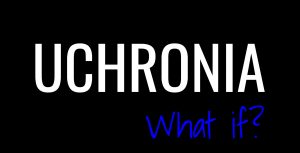
Uchronia|What if?, an exhibit that consists of "uncommon, digital versions of the world and of history." Source: Bertrand Gervais and Uchronia|What if? website.
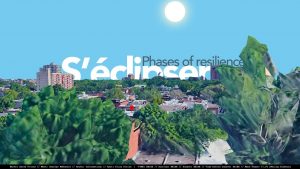
A promotional image for S'éclipser (2020), a 3-part exhibit that thinks about technocriticism and ecofeminism through art about materiality. Source: Bertrand Gervais.
I realize I often use the plural form (“we”), when talking about the NT2 Lab’s projects. The reason is simple: most of these projects are collective. They are the result of a collaborative effort. The professors (Joanne Lalonde, Sophie Marcotte, René Audet, Vincent Lavoie, etc.). the graduate students, the media team, the coordinators and the research assistants get together to plan, elaborate and realize our projects, from the RKE we develop and the virtual exhibits to the conferences and colloquia, the podcasts, the e-lit performances, etc. If the NT2 Lab has been successful, it is because of the sense of community we managed to create and maintain throughout the years.
DS: What is the relationship between Figura and the NT2 Lab? Those are two massive projects you’ve been working on.
BG: At the same time as I was building the NT2 Lab, I was also the founding director of Figura (Vincent Lavoie is now its director), the research center funded by the Fonds de recherche du Québec – société et culture (FRQSC). Figura brings together more than 51 professors and 400 graduate students, from 7 universities and 4 CEGEPs. Its main objective is to understand contemporary imagination, through cultural, artistic and literary practices. Such a wide-ranging project is extremely fascinating to develop and the possibilities in terms of research are far reaching. Evidently, the NT2 research orientations feed directly into this program. It is difficult to describe contemporary imagination and culture, without taking into account the way computers and IT are transforming our lives and modes of communication and interaction.
When I was the director, I approached my colleagues at Figura with the possibility of imagining new strategies to publish research, namely in the form of Research and Knowledge Environments (RKE), and to help convince them we gave out internal grants to help organize and put projects online. Thus, at the NT2 Lab, we started receiving proposals for RKE. We did not just theorize the advantages and forms of RKE, we set out to do them on a major scale. We didn’t develop from scratch the content management system we were using, we chose the open source CMS Drupal and used it to answer the needs of our community. Our aim was not to build a prototype, but to deploy an ecosystem of online RKE dedicated to the study of contemporary imagination and culture. And then, to see it evolve. The objective of this ecosystem was and still is to renew the way research is carried out and published on the Internet, by creating structured research platforms that are institutionally recognized (by being part of a university research center for instance) and linked by the same search engine. Our ecosystem on the contemporary offers resources on popular culture, contemporary literary and artistic forms, geopoetics, ethnocriticism, research-creation, translation, etc. We also have academic journals, among with Captures, our peer-reviewed journal dedicated to studying the figures, theories and practices of the imaginary.
I want to give an example of the type of results such a perspective on contemporary imagination and culture can give. The project, entitled Archiving the Present. Exhaustivity as an Aesthetics in Contemporary Cultural Practices is a Research and Knowledge Environment which started late 2018, and it is a direct consequence of the Hypermedia Art and Literature Directory. Having spent 15 years describing and cataloguing hypermedia art, we realized that a new paradigm in the creative process had appeared, one where, to put it in a nutshell, systematicity was favored over originality, fascination or obsession for an object over mastery of an art or a technique, and exhaustivity of description over precision of execution. This paradigm shift is present not just in digital aesthetics or in what Lev Manovich calls info-aesthetics, but in all types of artistic and cultural practices. So we set out to prove this hypothesis, and to do this we conceived the Archiving the Present RKE. The central piece of the project is the Collection, a Directory of all types of works based on a systematic approach. These works range from literary texts to found footage, videos, photography and post-photography, to collages, performances, artist books, etc. Together, they form an aesthetic, a digital aesthetic.
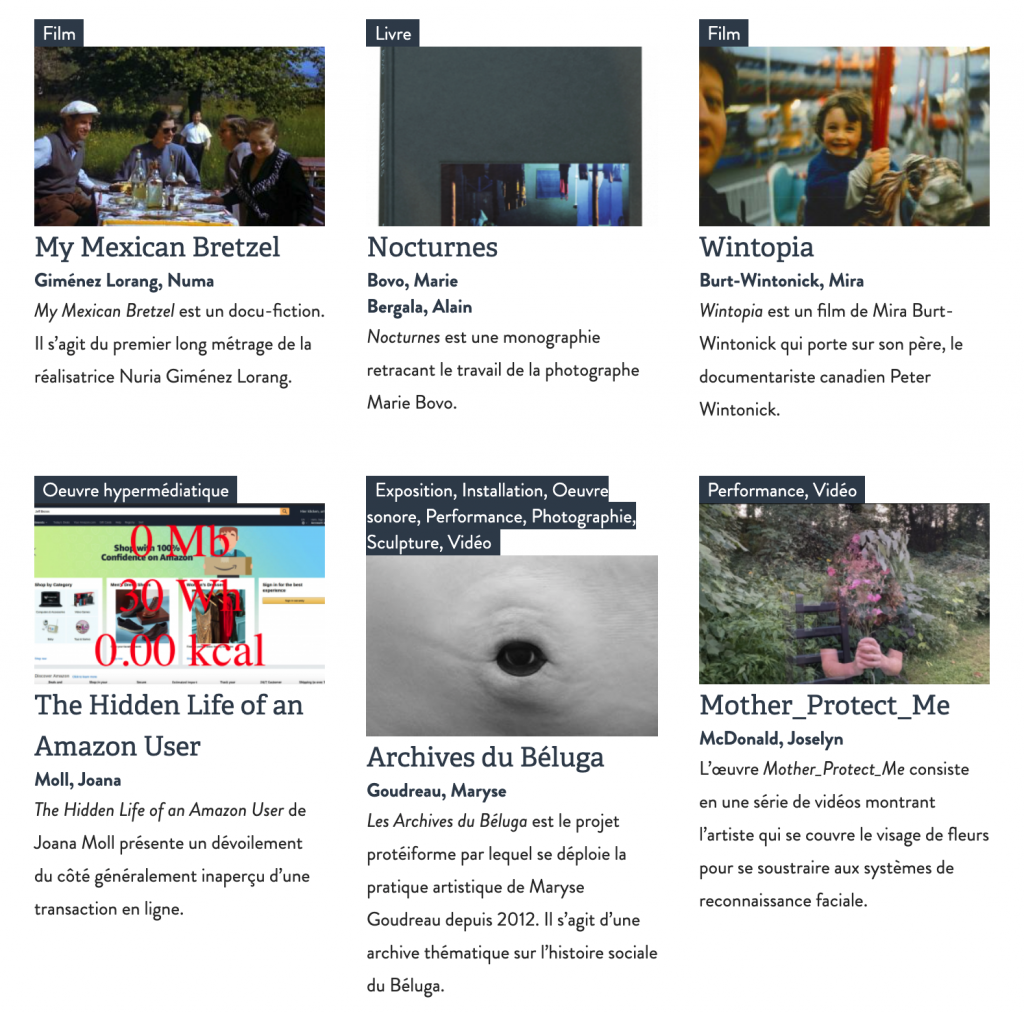 Sample works from the Collection of the Archiver le Present project. Source: project website.
Sample works from the Collection of the Archiver le Present project. Source: project website.
DS: I’d love to talk about the issue of genre naming and labelling. For example, how should we translate “littératures numériques” into English? What is its closest English counterpart? And how does it differ from “hypermediatique”?
BG: Translation is always a complex activity. Simply put, I would say: hypermédiatique becomes hypermedia; and littérature numérique, digital literature.
When we started working with the notion of “hypermedia” at the NT2, we wanted to use the most neutral notion we could think of, not wanting to get into a debate about names (Net Art, New Media, Technotextuality, Ergodic Literature, etc.). Hypermedia simply represented a hypertextual project that was multimodal, using therefore numerous media. It was a technical term more than anything else.
Since then, the adjective “digital” (numérique) has become prevalent and everything that was electronic, new media, hypermedia has now become digital. There is a loss of meaning, the “digital” representing such a wide variety of phenomena (I had a digital watch when I was a kid…). But the word has a strong echo in the public sphere. It seems generic enough to be used in numerous contexts. Thus, provincial and federal agencies all have programs dedicated to financing “digital” culture, art, literature, projects and infrastructures.
For us, at the NT2 lab, the shift from hypermedia to digital did force us to reevaluate our own Directory. For the first twelve years, our Hypermedia Arts and Literature Directory was an ongoing project that covered no specific period. The works listed started with Electronic Literature and its forerunners, but there was no end in sight. We just added more and more projects, as they were published, refining as we went along our analytical tools. But, as softwares evolved, as Flash, for instance, was dragged in a commercial war between Adobe and Apple which led to its demise, and as social medias gained more and more traction, it became evident that our Directory was becoming, not so much obsolete as historical. Artists and writers started to use social medias with detournement strategies, having fun court circuiting GAFAM’s platforms, and did a lot less coding. The shift towards the digital signalled that we were in the presence of a third generation of electronic literature, to use Leonardo Flores distinction. If the first generation described the pre-web literature, and the second one, the hypermedia works, the web-based practices integrating multimedia and interactivity, the third generation is that of digital literature as such, a form that makes use of all the devices and platforms made available by recent computer developments. Evidently, this third generation encompasses the first two that continue to have their followers and epigones, but it does modify the perspective on the first two generations, giving them an historical dimension.
For our Directory, the emergence of this third generation begs the question of its relevance, and therefore of its future. Our hypermedia categories seem outdated, for instance the importance on the interactive and multimedia dimensions. We have yet to decide what we will do, but we know we’ll have to adjust our modes of research.
DS: Canada has many research resources and labs dedicated to digital arts, media studies, and digital literary studies, including Caitlin Fisher’s Augmented Reality Lab in Toronto, Brian Greenspan’s HyperLab in Ottawa, Karis Shearer’s AMP Lab in Kelowna, Marcel O'Gorman’s Critical Media Lab in Waterloo, and your own NT2 Lab in Montréal. Are there other Canadian labs or resources you’d like to foreground in particular?
BG: I think we could add to this list of major projects, the Ex Situ Laboratory, led by René Audet at Université Laval, which focuses on digital literature and culture, as well as on editorial innovation, open scientific archives and scientific dissemination. Another noteworthy project is Marcello Vitali-Rosati’s Canada research Chair on digital Textualities, at Université de Montréal. The work his team does on the editorialization process and digital culture is fascinating. I can also think of Hexagram, the interdisciplinary network dedicated to research-creation addressing the relationships between arts, cultures and technologies; and, evidently, I have to add to this list the Centre de recherche interuniversitaire en humanités numériques (Interuniversity Research Center on Digital Humanities), led by Michael E. Sinatra, from Université de Montréal. These infrastructures are fine examples of the work that has been done in Québec to understand digital culture and to develop original perspectives and modes of research using digital tools.
DS: Thinking about digital publishing and electronic literature as potential “alternatives” to print publishing in Canada, have you noticed a difference between the ways that Anglophone and Francophone Canada have treated electronic literary production?
BG: One of the decisions we took, when we started building the Directory, was not to put up barriers and define boundaries, but on the contrary, to try to have the most open attitude possible, and to encompass the widest range of projects. We did not want to reproduce what has been happening in art and literature for quite some time, defining genres and subgenres, establishing categories that separated practices and artists. So we set up the Directory with no preconceived idea as to what type of art was being produced (also the two directors came from different discipline: Joanne Lalonde is in the Art History Department, while I’m in the Literary Studies Department). A digital culture was taking shape, and those who engaged in it and wanted to produce new forms of work came from every disciplines. The works we assembled came from literature, visual arts, theater, cinema, video, even video games. In describing them, we were more interested in the way they forced interactivity upon their readers or spectators, played with numerous media or engaged in specific contemporary themes, than the disciplines they represented. In the same manner, we did not try to have a national agenda. In our metadata, we do identify the origin of the work described, but it is solely for statistical purposes. We could say that from the very beginning most of the works came from the English sphere, but we made an explicit effort to cover works from France, Spain, Portugal, Germany, Canada and Québec, evidently. We did not try to uncover a national identity to these new works, in fact we abandoned such a frame of reference; we tried instead to show what made them relevant to contemporary imagination and culture. It is not often that a new media appears, one that is so powerful that it can transform the very basis of our societies; when that happens the question of nationality becomes of a secondary nature. That is to say, it was not really present in our work.
In the last few years, I did go back to working specifically on Québécois literature, but my perspective is completely different, and the aim of this new project is less to understand new forms of literature and art, it is rather to develop strategies and tools to help a specific community, the Québécois literary community, evolve in a digital world. I’ll get back to it later.
In Canada, as you well know, there are two official languages, and evidently a host of other languages. The French and the English communities are quite separate, and I don't think they understand each other quite well. They have their own institutions, their own set of conventions and rules, their own cultural references! We did not try to compare these two communities, we tried most and foremost to present and valorize what they did, independently of the language used. We worked therefore with both communities, especially on the local Montreal scene.
Even though I do a lot of my work in English and my main area of expertise is American literature, I decided to do my work in French, especially while working on digital literature, because of the very nature of the changes we were witnessing. I wanted my own province, my own culture to become aware of how computers and the Internet we're transforming our society, and to do so it was obvious for me that I had to work in French. I also teach in a French University where most of my students speak, think and write in French. I have a responsibility to teach them in our language, to offer tools that enable them to understand our world. Thus, the Directory and the Ecosystem we built with Figura is predominantly in French, even if the theory behind it comes from the USA and the English academia.
I work as a “passeur”, a courier if you want. I translate notions from one culture to another, making sure they have the biggest possible impact. I always liked Yuri Lotman’s notion of semiospheres. It is a spatial model for the interpretation of culture, a semiosphere being based on one language, which serves as its major semiotic and symbolic tool. What is interesting with semiospheres is that they permit, through their boundaries with other semiospheres, communication and the introduction of new words, new notions, new forms of representation and ways of speaking. For me, semiospheres are not a theoretical question, they are a very pragmatic idea. I want my semiosphere, the Québécois culture, existing in Québec, to be in a dynamic relationship with the other semiospheres it has boundaries with, not just with France, but with English Canada and the United States. This relationship works not only on the obvious level of cultural practices and products, films, music, literature, but also on the more subtle aspects of media and their ways of constructing our social reality.
DS: How do digital storytelling and e-lit serve as alternatives to the print publishing industry in Canada? Does the Canadian publishing industry’s attitude towards what counts as literary and thus “publishable” literature present barriers to exploring alternative literary forms? Have you witnessed any changes over recent decades?
BG: The relationship between e-lit and the more traditional print publishing industry has been strained for quite some time. The publishing industry has seen, and still does on some level, the digital world and its editorializing capacities, as a kind of enemy. As if, to repeat Victor Hugo’s oft-quoted sentence in Notre-Dame de Paris, “Ceci tuera cela”. This tension has started to dispel lately, especially with a new generation of editors, a younger crowd if I can say so, who is not afraid of the digital, but wants on the contrary to use it both to market and valorize their books and projects, and to propose alternative literary forms. The tide has started to turn.
I decided I really wanted to help this shift and, with a group of researchers close to the NT2 Lab, we started a partnership project: Littérature québécoise mobile (LQM). After a three-year development grant, we were really happy to get major funding for the project by the Social Sciences and Humanities Research Council of Canada (2019-2024). The LQM partnership, unique in the French-speaking world, responds to the urgency of the Québec literary community to mobilize around new platforms and tools. LQM intends to encourage the co-production of knowledge between academics and professionals by facilitating spaces for dialogue and the dissemination of knowledge. This partnership is also an opportunity to broaden and solidify literary communities while increasing the presence of Québec literature through digital devices. Raising awareness and deepening know-how are at the heart of LQM's work. More than ever, authors, publishers, researchers, readers and organizations dedicated to the promotion of Québec literature recognize the importance of operating in a digital culture. This is a vast field of research that involves poetics, semiotics, theories of reading and interpretation, sociocriticism, history of the book, creative writing, research-creation, etc.
The partnership is divided into two components: a literary component, which opens into two distinct poles, the Montréal and Québec City poles, which together cover the largest number of literary activities in Québec; and an educational component (directed by Nathalie Lacelle, UQAM), concerned with forms of digital literacy and the transformation of publishing, mediation and reception practices in digital children and youth literature. Our work has already started, even if we were slowed down by the Covid-19 Pandemic.
Among the numerous subprojects integrated into the partnership, I would like to foreground Opuscules, our web-app which is in its second version (a third one is in the works). Opuscules is the result of a close collaboration between LQM and teams from UNEQ (Union des écrivaines et des écrivains du Québec), the NT2 Lab, with some help by Koumbit.org, a non-profit organization. It offers a range of resources: an anthology of previously unpublished literary texts written by UNEQ authors (two every month), that come with an audio version, recorded thanks to an agreement with CHOQ.ca web radio. In addition, there is an audio library offering recordings of literary events (readings and literary happenings, conferences, round tables, discussions). The web-app provides access to a directory of some 1,200 authors, organizations and literary contributors who have produced content for it. Such a project serves the three major goals of the LQM partnership: to document the transition we are engaged in, to support our partners in their work, and to take part in the literary community (I am a novelist, so this is also my community!). Opuscules a mediation and discovery tool serving the literary community, while (openly) collecting data on its contributors, on events and on current literary practices for research purposes.
DS: Recently, you published the ELO 2018 Mind the Gap conference proceedings that are open access. Do you have any thoughts to share about how we are opening access through publication in the field of electronic literature, in Canada, and/or in academia?
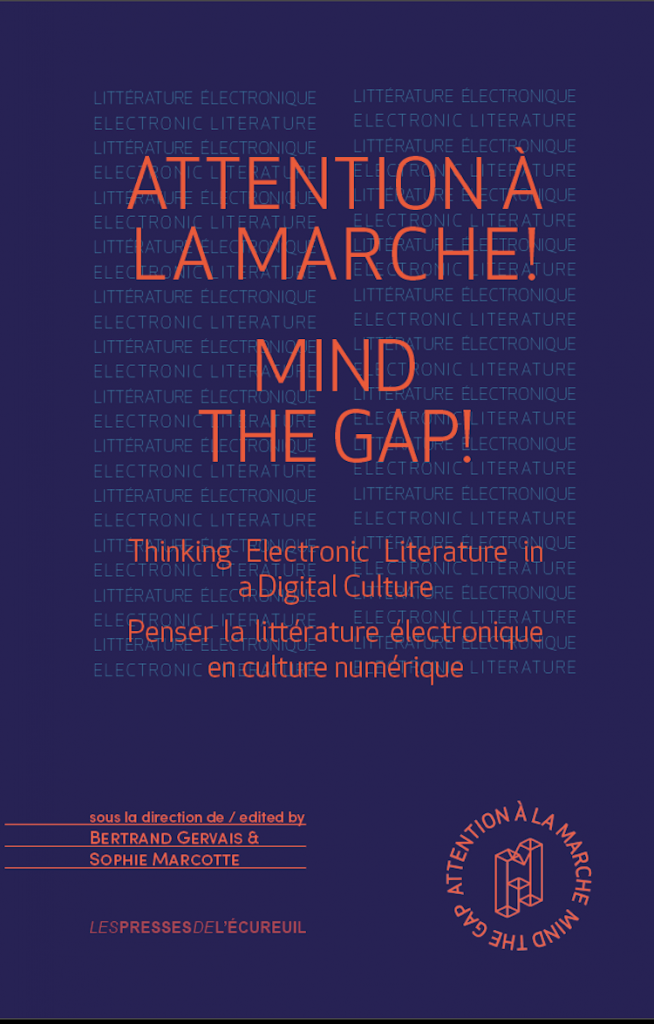
The cover of Attention à la Marche!: Penser la littérature électronique en culture numérique / Mind the Gap!: Thinking Electronic in a Digital Culture, with proceedings from the 2018 ELO Meeting. Source: Bertrand Gervais.
BG: I’m really proud of the work we did on the Mind the Gap! / Attention à la marche! proceedings of the 2018 ELO conference, held in Montréal. From the onset, it was clear, for Sophie Marcotte and I, the co-editors, that we were not going to go for a printed book, but an ePub. They were many reasons for that. A lot of the works quoted and analyzed in the articles existed on the Internet, and it didn’t make any sense to publish texts that could not refer directly to their object. We didn’t want to have low grade black and white reproduction of figures that could be present in full colors in a digital format. We also wanted our book to be free for the writers and all the readers, given the collective nature of the project (and the fact that all the research behind the papers had already been paid for by governments). Going for an ePub format gave us the liberty to offer the proceedings directly on our NT2 website in different formats (as well as offering it on ePub platforms). Collaborating with les Presses de l’écureuil, a young French editor who did wonderful work, we even managed to do a P.O.D. version of the book, for those who prefer nonetheless a printed format.
As we see more and more editors shy away from essays and monographs, because they are not profitable, it is important to explore other modes of publishing, not just cheaper modes, but modes that answer direct needs, modes that enable conventions and uses to evolve.
I found the whole editing process to be quite compelling, I must admit. Playing with various formats, embedding hyperlinks, preparing a version for dyslexics, seeing the completed book appear on my computer screen. In terms of academia, the same work went into preparing the texts for their final version. But the printing aspect was greatly compressed. When the book was ready, from our editorial point of view, it was simply ready! And we could just send it to the writers in its finished form! There was even an added bonus to the virtual version of the collective. Usually, when you print a book and send it to its writers/collaborators, you never know when they receive it, when they read it (or just look at it); they almost never write back. There is a form on anonymity in the process. When we sent the URL to our collaborators so they could download the book in its ePub version, a lot of them answered back rapidly, happy to have received it, commenting on the visual aspect of the book! It might be the newness of the process, but somehow everything became much more dynamic. The writers wrote back! For an editor’s point of view, it was a godsend.
The ELO 2018 Mind the gap! / Attention à la marche! conference in Montreal was a marvelous adventure and the just released ePub is its perfect ending. We wanted to explore how electronic literature adapted to digital culture, how an avant-garde literature based on coding could cope with evolutions of computer technology, and we ended up enacting such an evolution, proposing an ePub, therefore using the editorialization process at the heart of the digital world.
Acknowledgements
Dani Spinosa would like to thank Bertrand Gervais for the generosity of his time, conversation, and contributing images.